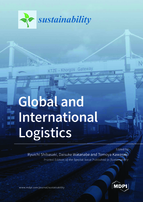Global and International Logistics
A special issue of Sustainability (ISSN 2071-1050). This special issue belongs to the section "Sustainable Transportation".
Deadline for manuscript submissions: closed (28 February 2021) | Viewed by 50086
Special Issue Editors
Interests: global logistics; intermodal transport; AIS
Special Issues, Collections and Topics in MDPI journals
Interests: logistics system engineering; logistics risk management
Special Issues, Collections and Topics in MDPI journals
Interests: supply chain management (SCM); value chain management (VCM); logistics systems optimization; graph analysis; big data analysis
Special Issues, Collections and Topics in MDPI journals
Special Issue Information
Dear Colleagues,
We are calling for papers for a Special Issue of the journal Sustainability on research related to global and international logistics. In the present world, with the recent advances in the globalization of trade and economic activity, research on the logistics issue should be approached from more global or international viewpoints, to achieve the sustainable economic development in the world. Global issues on the logistics field include not only international cooperation and cross-border issues, but also intermodal transport, global shipping network analysis, supply chain integration and coordination, intelligent transport system and information technologies, green and reverse logistics, impacts of China’s Belt and Road Initiative, and others. Furthermore, since the current advancement of information technologies enables us to use some kinds of big data in the global logistics field, we also encourage you to propose new ideas on big data analysis in this field.
This Special Issue will be related to the 8th International Conference on Transportation & Logistics (TLOG 2020) which will be held in Surabaya, Indonesia on 6–8 September 2020 (https://tlog2020.uisi.ac.id/). Some of the papers to be published will be selected from the papers submitted to this conference. However, we are broadly calling for papers for this SI, not limited to these conference papers and expect many contributions from experts in the field. If you have any questions, please do not hesitate to contact us.
Prof. Ryuichi Shibasaki
Prof. Dr. Daisuke Watanabe
Prof. Dr. Tomoya Kawasaki
Guest Editors
Manuscript Submission Information
Manuscripts should be submitted online at www.mdpi.com by registering and logging in to this website. Once you are registered, click here to go to the submission form. Manuscripts can be submitted until the deadline. All submissions that pass pre-check are peer-reviewed. Accepted papers will be published continuously in the journal (as soon as accepted) and will be listed together on the special issue website. Research articles, review articles as well as short communications are invited. For planned papers, a title and short abstract (about 100 words) can be sent to the Editorial Office for announcement on this website.
Submitted manuscripts should not have been published previously, nor be under consideration for publication elsewhere (except conference proceedings papers). All manuscripts are thoroughly refereed through a single-blind peer-review process. A guide for authors and other relevant information for submission of manuscripts is available on the Instructions for Authors page. Sustainability is an international peer-reviewed open access semimonthly journal published by MDPI.
Please visit the Instructions for Authors page before submitting a manuscript. The Article Processing Charge (APC) for publication in this open access journal is 2400 CHF (Swiss Francs). Submitted papers should be well formatted and use good English. Authors may use MDPI's English editing service prior to publication or during author revisions.
Keywords
- Global logistics
- Intermodal transport
- Logistics network
- Big data on logistics
- Cross-border issues
- Maritime shipping
- Global supply chain
- Regional coordination and cooperation in transportation logistics
- ITS and IT
- Green logistics and reverse logistics
- Belt and Road Initiative








